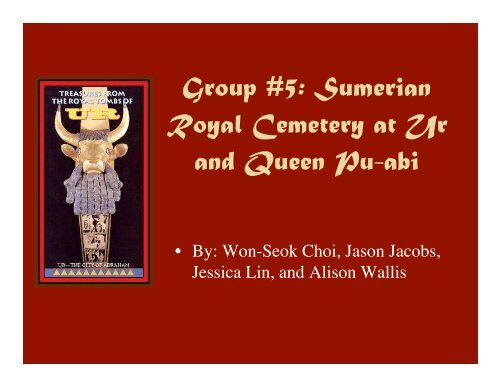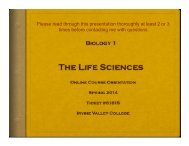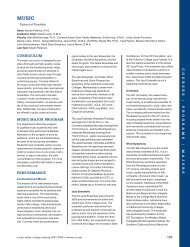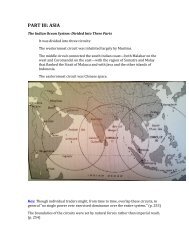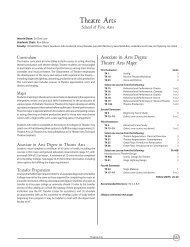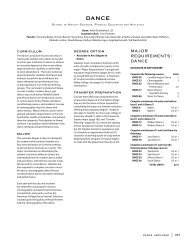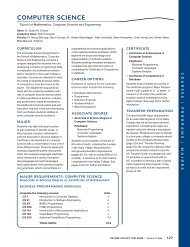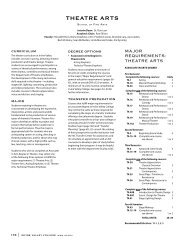Create successful ePaper yourself
Turn your PDF publications into a flip-book with our unique Google optimized e-Paper software.
Group #5: <strong>Sumerian</strong><br />
Royal <strong>Cemetery</strong> at <strong>Ur</strong><br />
and Queen Pu-abi<br />
• By: Won-Seok Choi, Jason Jacobs,<br />
Jessica Lin, and Alison Wallis
• Historical Context<br />
(3 pages)<br />
Presentation Map<br />
• Ram Caught in a Thicket<br />
(2 pages)<br />
• Standard of <strong>Ur</strong> (2 pages)<br />
• Cultural Influences<br />
(2 pages)<br />
• The Great Lyre (2 pages)<br />
• Subject and Style<br />
• Silver Head of a Lion<br />
(2 pages)<br />
• Processes and Materials<br />
• The Headdress of Queen<br />
Pu-abi (2 pages)<br />
• Printed Sources and<br />
Links (2 pages)<br />
• Works Cited (2 pages)
Historical Context<br />
By Jessica Lin<br />
• <strong>Ur</strong> was an ancient city in southern Mesopotamia located near the<br />
original mouth of the Tigris and Euphrates Rivers. The remaining of<br />
the city are currently known as Iraq. The city of <strong>Ur</strong> was founded<br />
sometime in the six thousand B.C. and occupied for nearly five<br />
thousand years. By 2500 B.C. <strong>Ur</strong> was the center of Mesopotamia due<br />
to its remarkable agricultural and material wealth. Its strategic<br />
location on the Euphrates, with waterway access to the Persian Gulf,<br />
helped it grow by the 3rd millennium into a major, fully urban center.<br />
(Horne, 1). <strong>Ur</strong> contained the greatest cemetery constructed at the peak<br />
of its early prosperity; around 2650 B.C. Conducted in an excavation<br />
project funded by the British Museum and the University of<br />
Pennsylvania Museum, Professor Wholley excavated nearly 1850<br />
burials. There are sixteen burial artifacts that were deemed royal<br />
because they contained distinctive construction, the wealthy contents,<br />
and they were buried with the remaining body parts of the deceased.
Historical Context Continued…<br />
• The royal burials contained enormous<br />
amounts of gold, electrum, and silver; lapis lazuli,<br />
carnelian, agate, and chalcedony. It contained a<br />
vast collection of jewelry and personal belongings,<br />
even cosmetics. Each tomb also contained from a<br />
half-dozen or more of dead bodies. Unfortunately,<br />
many of these tombs have either been looted or<br />
damaged before Wholley’s historical excavation.<br />
However, the tomb of queen Pu-abi was kept<br />
mostly intact. Pu-abi, identified by a lapis lazuli<br />
seal carved with her name, was clearly an<br />
extraordinary important woman in her day. Her<br />
tomb contains lots of wealthy artifacts as well as<br />
great amounts of history and information about <strong>Ur</strong>.
Historical Context Continued…<br />
• The city and of <strong>Ur</strong>, which contained rare and exquisite <strong>Sumerian</strong><br />
artifacts from the renowned, 4500-year-old royal cemetery at <strong>Ur</strong> is<br />
known to the world as the city famed in the Bible as the home of the<br />
patriarch Abraham (Parchin, 1). In the second half of the third<br />
millennium, Sumer and its city-states fell to Sargon I, the conqueror<br />
who unified Mesopotamia and created the Akkadian Empire. The city<br />
rebounded by a brief resurgence of power at the end of the three<br />
thousand B.C. under the ruling of <strong>Ur</strong>-Namma and his Third Dynasty.<br />
During this period, the massive ziggurat of <strong>Ur</strong> was raised. However,<br />
the city never regained its prosperity that it once reached, and the city<br />
was not heard until the excavation of the Royal <strong>Cemetery</strong> of <strong>Ur</strong> and<br />
Queen Pu-abi by Professor Leonard Wholley.
Ram Caught In a Thicket<br />
ca. 2650-2550 BC<br />
By Jessica Lin<br />
• The Ram in a Thicket was discovered<br />
in the Royal <strong>Cemetery</strong> of <strong>Ur</strong> by the<br />
great excavator Leonard Wholley in the<br />
"Great Death Pit" at <strong>Ur</strong>. It was made<br />
around 2650-2550 B.C. The artifact is<br />
estimated at 45.7 centimeters tall and<br />
30.48 centimeters wide. It was named<br />
the 'Ram in a Thicket', or sometimes<br />
"Ram Caught in a Thicket" by Wholley<br />
who liked biblical allusions. In this<br />
context, Wholley associated it with the<br />
ram caught in a thicket in the biblical<br />
story of Abraham and the intended<br />
sacrifice of Isaac.
Ram Caught in a Thicket Continued…<br />
• In Genesis 22:13, God ordered Abraham to sacrifice his son Isaac, but at the last<br />
moment 'Abraham lifted up his eyes, and looked, and behold behind him a ram<br />
caught in a thicket by his horns: and Abraham went and took the ram, and offered<br />
him up for a burnt offering in the stead of his son (British Museum, 1). In this story,<br />
<strong>Ur</strong> was the birth place of Abraham who sacrificed a ram instead of his son, Isaac.<br />
Nevertheless, art historians believe that it is a goat standing on its hind legs eating<br />
the leaves of a tree.<br />
• The statue is an amazing example of an artifact made from delicate and composite<br />
materials. The artifact is composed of gold, silver, lapis lazuli, copper, shell, red<br />
limestone and bitumen. It was badly crushed when it was discovered, and wax was<br />
used to keep the pieces together as it was lifted from the ground, and it was then<br />
pressed back into shape. This delicate work was probably part of a larger sculpture,<br />
perhaps a support for a table used in an elaborate <strong>Sumerian</strong> ritual (Thicket in the<br />
Ram, British Museum, 1). This artwork is rich in symbolism. For example,<br />
<strong>Sumerian</strong>s were acutely concerned with animal fertility and the fecundity of<br />
vegetation. Therefore, the artifact is surrounded by stylized rosettes representing<br />
Inanna, goddess of love, fertility and conversely, and war (Parchin, 1). The artifact<br />
is permanently collected by the University of Pennsylvania Museum, and<br />
everybody should visit this magnificent artwork once in a life time.
• The Standard of <strong>Ur</strong>, also known as<br />
the "Battle Standard of <strong>Ur</strong>," or the<br />
"Royal Standard of <strong>Ur</strong>”, was<br />
excavated by Professor Wholley<br />
from the Royal <strong>Cemetery</strong> in the<br />
ancient city of <strong>Ur</strong>. It was a<br />
<strong>Sumerian</strong> artifact made around<br />
2,600-2,400 B.C. The Standard is a<br />
hollow wooden box measuring 8.5<br />
inches high and 19.5 inch long, and<br />
it’s made with a mosaic of shell,<br />
red limestone and lapis lazuli. Its<br />
original function is not known,<br />
however, Leonard Wholley<br />
suggested that it had been carried<br />
on a pole, borne as a standard.<br />
Standard of <strong>Ur</strong><br />
ca. 2650-2550 BC<br />
By Jessica Lin<br />
•It has also been speculated that it<br />
was the sound box of a musical<br />
instrument.<br />
(Standard of <strong>Ur</strong>, Wikipedia, 1).
Standard of <strong>Ur</strong> Continued…<br />
• The object contained two main panels called War and Peace. The War<br />
section depicted a march by the <strong>Sumerian</strong> army. The <strong>Sumerian</strong> army<br />
was likely engaged in a border skirmish. The panel contained soldiers<br />
on chariots trampling enemies; infantry with cloaks carry spears;<br />
enemy soldiers killed with axes; spearmen clad in armored cloaks; and<br />
other infantrymen bearing sickle-like knives or axes. The panel also<br />
depicted wounded, naked, and humiliated prisoners being presented to<br />
the king who holds a spear (Standards of <strong>Ur</strong>, British Museum, 1).<br />
• On the other hand, the "Peace" panel depicts a banquet scene and also<br />
various scenes of life: animals, fish and other goods are brought in<br />
procession to a banquet; seated figures, wearing woolen fleeces or<br />
fringed skirts, drink to the accompaniment of a musician playing a<br />
lyre (Standard of <strong>Ur</strong>, Wikipedia, 1). The lyre that the harpist played in<br />
the “Peace” panel was identical to the great Lyre of <strong>Ur</strong> that was also<br />
excavated by Professor Wholley in the <strong>Cemetery</strong> of <strong>Ur</strong>. The great<br />
Standard of <strong>Ur</strong> is currently a permanent collection of British Museum.<br />
It was a remarkable artifact and it was an important piece of history<br />
which enabled everybody to understand the magnificent <strong>Sumerian</strong><br />
Era.
Cultural Influences<br />
By Won-Seok Choi<br />
• Lavish jewelry of gold and lapis lazuli, cups of gold and silver, bowls<br />
of alabaster, and extravagant objects of art and culture were among<br />
the Mesopotamian treasures discovered in the late 1920s by famous<br />
British archaeologist C. Leonard as part of a joint expedition by the<br />
British Museum and the University of Pennsylvania Museum<br />
(Parchin, 1). One of the most amazing discoveries he made in ancient<br />
Mesopotamia was the royal cemeteries at <strong>Ur</strong> and the exquisite<br />
artifacts from there, which revealed the glory of ancient <strong>Sumerian</strong><br />
culture of the third millennium B.C. We see from the cemetery and<br />
many artifacts of the royal cemetery at <strong>Ur</strong> that much of their art meant<br />
for funerary and religious purposes. In the third millennium B.C., the<br />
leading families of <strong>Ur</strong> buried their deceased in vaulted chambers<br />
under the earth. In the cemeteries at <strong>Ur</strong>, excavators found gold<br />
daggers and helmets, golden beakers and bowls, jewelry, musical<br />
instruments, and a lot more luxuries.
Cultural Influences Continued…<br />
• They also found dozens of bodies of musicians,<br />
soldiers, and servants that have been sacrificed to<br />
accompany the kings, queens, or aristocrats. In this<br />
sense, the royal cemetery at <strong>Ur</strong> provides a glimpse<br />
into the ancient <strong>Sumerian</strong> culture, in which people<br />
believed that there is an afterlife that carried a great<br />
deal of significance among the <strong>Sumerian</strong>s. This<br />
cultural belief led the ancient <strong>Sumerian</strong>s to produce<br />
luxurious musical instruments that would entertain<br />
the deceased and golden daggers and helmets to<br />
protect the dead. Many other artifacts from the<br />
royal cemetery at <strong>Ur</strong> were created for this purpose.<br />
• A theme frequently reflected in artifacts found in<br />
the cemetery is that of a funerary banquet. The<br />
scenes from the sound box of the Great Lyre from<br />
the “King’s Grave” depicts composite animals<br />
feasting, and other artifacts such as golden beakers<br />
and bowls shows a banquet. The use of animals<br />
and their features is frequently seen in the artifacts<br />
discovered in the royal cemetery at <strong>Ur</strong>.<br />
•The Great Lyre, Ram in the<br />
Thicket, and Silver Head of a<br />
Lion all depict an animal or it<br />
features. This indicates their<br />
“belief in power over the<br />
physical world by combination<br />
of various species' physical<br />
attributes” (Parchin, 1).
The Great Lyre<br />
ca. 2650-2550 BC<br />
By Won-Seok Choi<br />
• Among the extravagant <strong>Sumerian</strong> artifacts from the<br />
<strong>Sumerian</strong> Royal <strong>Cemetery</strong> at <strong>Ur</strong> such as jewelry of gold,<br />
cups of gold and silver, bowls of alabaster, and objects of<br />
art was one of the world's earliest known musical<br />
instruments: a large wooden lyre with the gold and lapis<br />
lazuli bull's head and plaque that has a series of panels<br />
describing mythical animals feasting. This splendid lyre<br />
that we now refer to as the Great Lyre from the “King’s<br />
Grave” or Bull-headed lyre for its magnificent bull’s head<br />
that caps the lyre’s sound box has been reconstructed<br />
according to the measurements made by the original<br />
excavators and now sits in the University of Pennsylvania<br />
Museum (British Museum Online, 1). Composed of gold,<br />
lapis lazuli, shell, and wood, the lyre is approximately<br />
5’5” high, its sound box being 1’7” high. It is fashioned<br />
of gold lead and lapis lazuli over a wooden core. The<br />
bull’s head attached to its front is also made of a wooden<br />
core covered by a sheet of gold, and details are of lapis<br />
lazuli and shell.
The Great Lyre Continued…<br />
• The trapezoid-shaped sound box underneath the bull’s<br />
beard bears four inlaid panels depicting feasting imaginary<br />
composite creatures and is composed of contrasting shell<br />
and bitumen. The first panel from the top features a heroic<br />
human-headed bearded bull embracing other human<br />
headed bulls in a heraldic composition, or in a symmetrical<br />
fashion on either side of a central figure, all shown in<br />
partial profile (Parchin, 1). The other three panels depict<br />
animals attending a funerary banquet such as a scorpionman,<br />
a dog carrying a laden table, a lion serving beverage,<br />
and an ass playing a lyre, all shown in profile. Parchin<br />
contends that the mixture of human and animal features in<br />
some of the figures in the scenes “represents a<br />
Mesopotamian belief in power over the physical world by<br />
combination of various species' physical attributes”<br />
(Parchin, 1). The meaning of the sound box scenes is<br />
much debated among scholars, but some have suggested<br />
that the animals in the scenes are of the dead world and<br />
that “the narrative has a funerary significance”.<br />
(Kleiner, 25)
Subject and Style<br />
By Jason Jacobs<br />
• <strong>Ur</strong>, along with the city-states of Larsa, <strong>Ur</strong>uk and Lagash, included<br />
what can best be described as Sumer in the southeastern part of the<br />
Fertile Crescent. The <strong>Sumerian</strong>s created some of the most beautiful<br />
art of their time. The <strong>Sumerian</strong>s artwork illustrates the theme of<br />
religious and funeral type purposes. The subject of war and peace also<br />
can be seen in some works. The theme of mythology was carried into<br />
the art pieces such as the Silver Head of a Lion. C. Leonard Woolley<br />
excavated <strong>Ur</strong>'s Royal <strong>Cemetery</strong> and he uncovered the treasures of<br />
Queen, or Lady Pu-abi. In these royal tombs, Woolley discovered the<br />
remains of an elaborate funeral and burial ceremonies of the Kings<br />
and Queens of <strong>Ur</strong>. <strong>Ur</strong>, previously known only through Biblical<br />
accounts as the home of the patriarch Abraham, became a historical<br />
reality with Woolley's astonishing discoveries. The royal tombs at <strong>Ur</strong><br />
opened the world's eyes to the full history of ancient <strong>Sumerian</strong> culture<br />
at its best between ca. 2600-2500 B.C.
Silver Head of a Lion<br />
ca. 2650-2550 BC<br />
By Jason Jacobs<br />
• For our group topic of <strong>Sumerian</strong> Royal<br />
<strong>Cemetery</strong> at <strong>Ur</strong> and Queen Pu-abi, I<br />
chose to interpret the Silver Head of a<br />
Lion. The Silver Head of a Lion was<br />
found in the royal tombs of the kings<br />
and queens of <strong>Ur</strong> between ca. 2650-<br />
2550 B.C.The Silver Head of a Lion<br />
came from the excavation of <strong>Ur</strong>'s Royal<br />
<strong>Cemetery</strong>. In the royal tombs of <strong>Ur</strong>,<br />
jewelry fashioned from gold, silver,<br />
carnelian, lapis lazuli, elegant vessels<br />
made of precious metals, stones, and<br />
shell, and a variety of utensils. This<br />
included items such as a gold drinking<br />
tube, silver and gold cosmetic sets.
Silver Head of a Lion Continued…<br />
• The weapons found in the tomb were also used by the<br />
royals. The Silver Head of a Lion demonstrated with its<br />
penetrating stare and its fierce outlook on evil. It is one of<br />
a pair presumably attached as an adornment to a wooden<br />
object. It is made of silver, shell and precious lapis lazuli.<br />
It is approximately 11 cm high and12 cm wide. The artist<br />
represented an animal central to <strong>Sumerian</strong> mythology.<br />
This ordain object created a magical talisman to ward off<br />
evil. There is subtle attention to detail as seen in both the<br />
lion's locks of hair and the intensity of its gaze. Once<br />
again, this stare suggests a fierce and menacing snarl.
Materials and Processes<br />
By Alison Wallis<br />
• The ancient <strong>Sumerian</strong>s used a variety of precious materials to create their<br />
elaborate works of art. Of the pieces found in the cemetery at <strong>Ur</strong>, many were<br />
made of gold, silver, copper, and electrum. The favorite of all the precious<br />
metals was gold. The gold they used was of the best quality ranging anywhere<br />
from 39k to 89k. It was soft and malleable making it easier to construct into<br />
elaborate details. The common process that they would use with gold would be<br />
that of pounding the gold until paper-thin. They would create gold leaf which<br />
commonly adorned many of their pieces. They also used wood and would carve<br />
it into musical instruments or plaques. Unfortunately the wood did not survive<br />
the decay and had to be reconstructed. Inlay was a seemingly popular process<br />
used by the craftsmen when working with wood. They would carve out scenes<br />
of animals from wood and then fill it in with different kinds of stone. The most<br />
common stones that were used in inlay are lapis lazuli, red limestone, shell, and<br />
bitumen. They only used the best of materials when creating pieces to go with<br />
the queen or king into the afterlife. They would also engrave stone seals that<br />
were buried with the queen and other important persons. They made very<br />
beautiful jewelry that would adorn the person from head-to-toe. This jewelry<br />
would be gold strands with beads of lapis lazuli and carnelian.
Headdress of Lady Pu-abi<br />
• This piece was originally<br />
worn by Queen Pu-abi over<br />
an elaborate hairstyle or wig.<br />
This headdress was probably<br />
not worn that often by Pu-abi.<br />
Inline with their beliefs in the<br />
afterlife, this piece was more<br />
than likely an offer to the<br />
gods. This piece is<br />
constructed from 40k gold<br />
that has been pounded until<br />
extremely thin and pliable. It<br />
is also adorned with strands<br />
of lapis lazuli and carnelian<br />
beads. At the end of each<br />
gold leaf is a small bead.<br />
ca. 2650-2550 BC<br />
By Alison Wallis
The Headdress of Lady Pu-abi<br />
• The headdress also consists of<br />
large crescent earrings that are<br />
constructed from the same 40k<br />
gold. To add to the already<br />
intricate headpiece there is a tall<br />
comb that has been pounded and<br />
cut into beautiful flowers. This<br />
adds to the femininity of the piece.<br />
This piece strongly reflects the<br />
pride that the <strong>Sumerian</strong>s took in<br />
the work and the reverence they<br />
showed to their gods and royalty.<br />
All of their work is crafted with<br />
the utmost care and with the best<br />
materials that are available to<br />
them.<br />
Continued…
Printed Sources and Internet<br />
Links for Further Information<br />
• Baumann, Hans: In the Land of <strong>Ur</strong>: The Discovery of Ancient<br />
Mesopotamia, translated by Stella Humphries. New York: Pantheon<br />
Books, 1969.<br />
• Kramer, Samuel Noah: The <strong>Sumerian</strong>s: Their History, Culture, and<br />
Character. Chicago: University of Chicago Press, 1963.<br />
• Reade, Julian: Mesopotamia. London: British Museum Press, 1991.<br />
• Finegan, Jack: Archaeological History of the Ancient Middle East.<br />
New York: Dorset, 1979.<br />
• Stefoff, Rebecca: Finding the Lost Cities. New York: Oxford<br />
University Press, c. 1997.
Printed Sources and Internet<br />
Links for Further Information<br />
• Woolley, Sir Leonard: Excavations at <strong>Ur</strong>: A Record of Twelve Years<br />
Work. New York: Crowell, 1955.<br />
• Zettler, Richard L. and Lee Horne, editors: Treasures from the Royal<br />
Tombs of <strong>Ur</strong>. Philadelphia: University of Pennsylvania Museum of<br />
Archaeology and Anthropology, 1998.<br />
• The Cleveland Museum of Art at www.clemusart.com/exhibit/ur<br />
• The Royal Tombs of <strong>Ur</strong> at www.mesopotamia.co.uk/tombs<br />
• McClung Museum at www.mcclungmuseum.utk.edu/specex/ur
Works Cited<br />
Won-Seok Choi<br />
• Parchin, S. 20<strong>06</strong>, Treasures from the Royal Tombs of <strong>Ur</strong>. About, Inc., the New<br />
York Times Company. 20<strong>06</strong>. April, 29, 20<strong>06</strong>.<br />
• <br />
• Horne, L. 1998. <strong>Ur</strong> and its Treasures: The Royal Tombs, Expedition. Vol. 40, No.<br />
2 < http://mcclungmuseum.utk.edu/specex/ur/ur-hist.htm><br />
• Standard of <strong>Ur</strong>. Wikipedia, 20<strong>06</strong>. Wikimedia Foundation, Inc.<br />
. April, 25, 20<strong>06</strong><br />
• Parchin, Stan. “Treasures from the Royal Tombs of <strong>Ur</strong>.” About.com. 20<strong>06</strong>. The<br />
New York Times Company. 4 May, 20<strong>06</strong>.<br />
.<br />
• The British Museum Online. 2000. Compass Collection Online. 4 May, 20<strong>06</strong>.<br />
• .<br />
• Kleiner, Fred, and Christin, Mamiya. Gardner’s Art through the Ages: the<br />
Western Perspective. 12 th Ed. Vol. 1. Belmont: Thomson Wadsworth, 20<strong>06</strong>.
Works Cited<br />
Jessica Lin<br />
• The British Museum Online, 2000. Compass Collection Online. April, 29.<br />
20<strong>06</strong>. <br />
• < www.thebritishmuseum.ac.uk/compass/ixbin/goto?id=obj1740><br />
Jason Jacobs<br />
• http://arthistory.about.com/library/weekly/bl_urrev.htm<br />
• http://www.stlouis.art.museum/index.aspx?id=176<br />
Alison Wallis<br />
• McClung Museum, 1999. http://mcclungmuseum.utk.edu/specex/ur/ur.htm<br />
• Wilson, Karen. The Oriental Institute Museum, The University of Chicago.<br />
http://oi.uchicago.edu/OI/MUS/INFO/NN_Fal00/NN_Fal00.html#fig5


